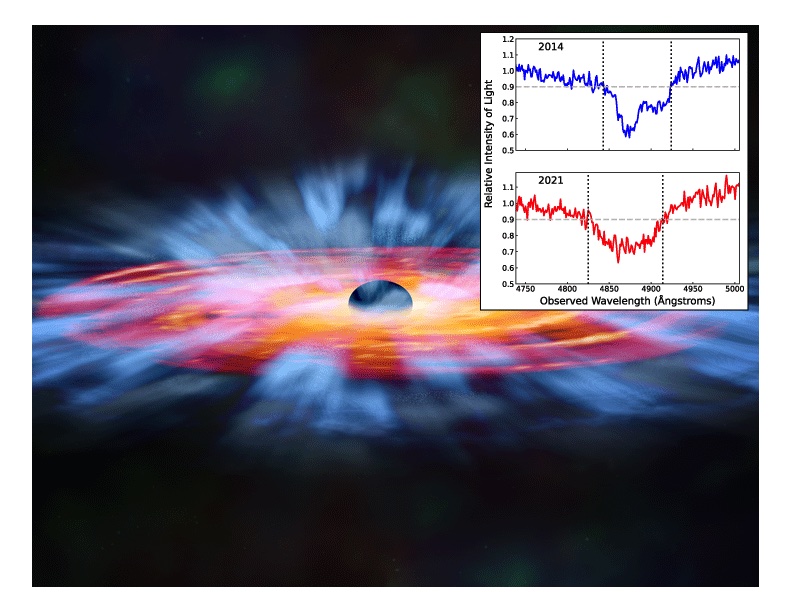
Black hole wind is speeding up, new study finds
Work by York astronomer and research colleagues in U.S. may provide clues into development of surrounding galaxies
TORONTO, June 11 2024 - Clouds of gas in a distant galaxy are being pushed faster and faster out among neighbouring stars by blasts of radiation from the supermassive black hole at the galaxy’s centre, a discovery that helps illuminate the way active black holes can continuously shape their galaxies by spurring on or snuffing out the development of new stars.

A team of researchers, including York University Faculty of Science Professor and Physics and Astronomy Chair Patrick Hall, revealed the accelerating gas through years of observations of a quasar — a black hole surrounded by a hot and bright disk of matter — some 30 billion light years away in the constellation Boötes.
Hall says that while this quasar acceleration has been seen before, including by researchers involved in this study, the level of detail here is unprecedented.
“We were able to make 130 observations over the course of eight years, so our confidence in this acceleration is quite high,” says Hall. “The difference in information could be compared to looking at two photographs at different points in time versus a movie.”
Black holes are believed to be situated at the centre of most galaxies. Quasars are supermassive black holes surrounded by disks of matter being pulled in by the black hole’s enormous gravitational power.
The research was led by University of Wisconsin–Madison astronomy professor Catherine Grier and recent graduate Robert Wheatley, and also included researchers from Pennsylvania State University, the University of Arizona, and others. The research was published today in The Astrophysical Journal and the findings are also being presented today at the 244th meeting of the American Astronomical Society.
“The material in that disk is always falling into the black hole, and the friction it feels heats up the disk and makes it very, very hot and very, very bright,” says Grier. “These quasars are really luminous and — because there’s a large range of temperatures from the interior to the far parts of the disk — their emission covers almost all of the electromagnetic spectrum.”

The bright light makes visible quasars nearly as old as the universe (and as many as 13 billion light years away when their light was emitted), and the broad range of their radiation makes them particularly useful for astronomers to probe the early universe.
Researchers used more than eight years of observations of a quasar called SBS 1408+544, collected by a quasar monitoring program carried out by the Sloan Digital Sky Survey now known as the Black Hole Mapper Reverberation Mapping Project. They tracked winds composed of gaseous carbon by spotting light from the quasar that was missing — light that was being absorbed by the gas. But instead of being absorbed at exactly the right spot in the spectrum that would indicate carbon, the shadow shifted farther from home with every new look.
“That shift tells us the gas is moving fast, and faster all the time,” says Wheatley. “We think the wind is accelerating because it’s being pushed by radiation that is blasted off of the accretion disk.”
The winds pushing gas out from the quasar are of interest to astronomers because they are a way in which the supermassive black holes might influence the evolution of the galaxies that surround them.
Depending on the circumstances, a quasar’s winds could supply pressure that squeezes gas together and speeds the birth of stars in its host galaxy. Or it could scour away that fuel and keep potential stars from forming.
To study quasars, astronomers look at their spectra, which is a measure of how much light the quasar gives off at each wavelength — from ultraviolet through the full visible spectrum from blue to red, and into infrared. A spectrum can reveal far more about a quasar than a simple telescope image — so by repeatedly measuring spectra over many years, astronomers can watch quasar light fluctuations and learn about the motion of the gas in the accretion disk, which can be used to determine the mass.
“Light has a force, so if you shine enough light on an object it can move,” says Hall. “We think that may be what's going on here, but it's not clear because I don't think we see enough of an increase in light to explain the acceleration we see. It's possible that wavelengths of ultraviolet light that we can’t observe directly are responsible, but right now it’s not clear. I look forward to seeing what this quasar does in the future.”
About York University
York University is a modern, multi-campus, urban university located in Toronto, Ontario. Backed by a diverse group of students, faculty, staff, alumni and partners, we bring a uniquely global perspective to help solve societal challenges, drive positive change, and prepare our students for success. York’s fully bilingual Glendon Campus is home to Southern Ontario’s Centre of Excellence for French Language and Bilingual Postsecondary Education. York’s campuses in Costa Rica and India offer students exceptional transnational learning opportunities and innovative programs. Together, we can make things right for our communities, our planet, and our future.
Media Contacts: Emina Gamulin, York University Media Relations and External Communications, 437-217-6362, egamulin@yorku.ca
